Atlas Fallen: Reign of Sand benefits from one of the small mercies in the digital age of gaming – the ability for a game to rebrand, remake and even relaunch itself post-release. Back in the day, this was largely impossible and games lived and died on their launch version, especially on console. But while on the one hand the digital age has brought unfinished cash-grab games to market far before they are ready, it has also allowed for the rebirth and resurrection of games that launched in a poor state. We are talking the Cyberpunk 2077 effect, or the rebirth of Final Fantasy 14 and No Man’s Sky.
Atlas Fallen wasn’t as bad as all that at launch. It had the bones of something great, but many drifted away before the credits rolled due to a variety of issues. An open world with not enough to do, a really jarring opening act, story and lore without the character to carry them, and a lack of the polish required to keep people wanting to play when there were just better games around.
Standing on the shoulders of its own previous version, Atlas Fallen: Reign of Sand is a free update so vast it fundamentally requires reevaluating the game in a stark new desert light. The opening act has been reworked, the story rewritten to bring you into the action quicker. New voice acting brings life to the bland character previously wrought. And for those already sold, it comes with new areas and arenas, new enemies and new abilities, a new game+ mode and a new difficulty level. We felt because of this large-scale revamp Reign of Sand deserved rediscovery and so we set out onto the open sands…
Desert Diaspora
In the world of Atlas Fallen: Reign of Sand, you play as the most downtrodden of all its peoples, the Unnamed, those felt undeserving even of their own identity. Slaves for the most part, they mine magical Essence from the planet. The world of Atlas is a tough one – barren, sand-dune covered, and infested with monsters called wraiths, humanity only survives in disparate settlements or well-guarded caravans if journeys must be made.
When one Unnamed ventures out of the caravan’s protection looking for his fellow slaves, he hears the call of an ancient artifact – a sentient talking gauntlet called Nyaal (who comes with a blue-bodied Avatar-like apparition to chat to). Yes, that sounds very Forspoken/Flintlock-like, and it is, but here at least it does not also come with masses of cringy New York Isekai dialogue. Ben Starr (Clive from Final Fantasy 16) lends his substantial talents to the voice of the male Unnamed and does an outstanding job of not alienating the player, not coming off annoying and cringy, and somehow breathing a bit of life into what had been an empty husk of a character.
Nyaal is not the annoying and sarcastic caustic relationship you have with Cuff in Forspoken. He is unfortunately a rather cliched amnesiac god-like figure with a seriously important past to uncover, but I didn’t find it much of a surprise. At least he wasn’t annoying.
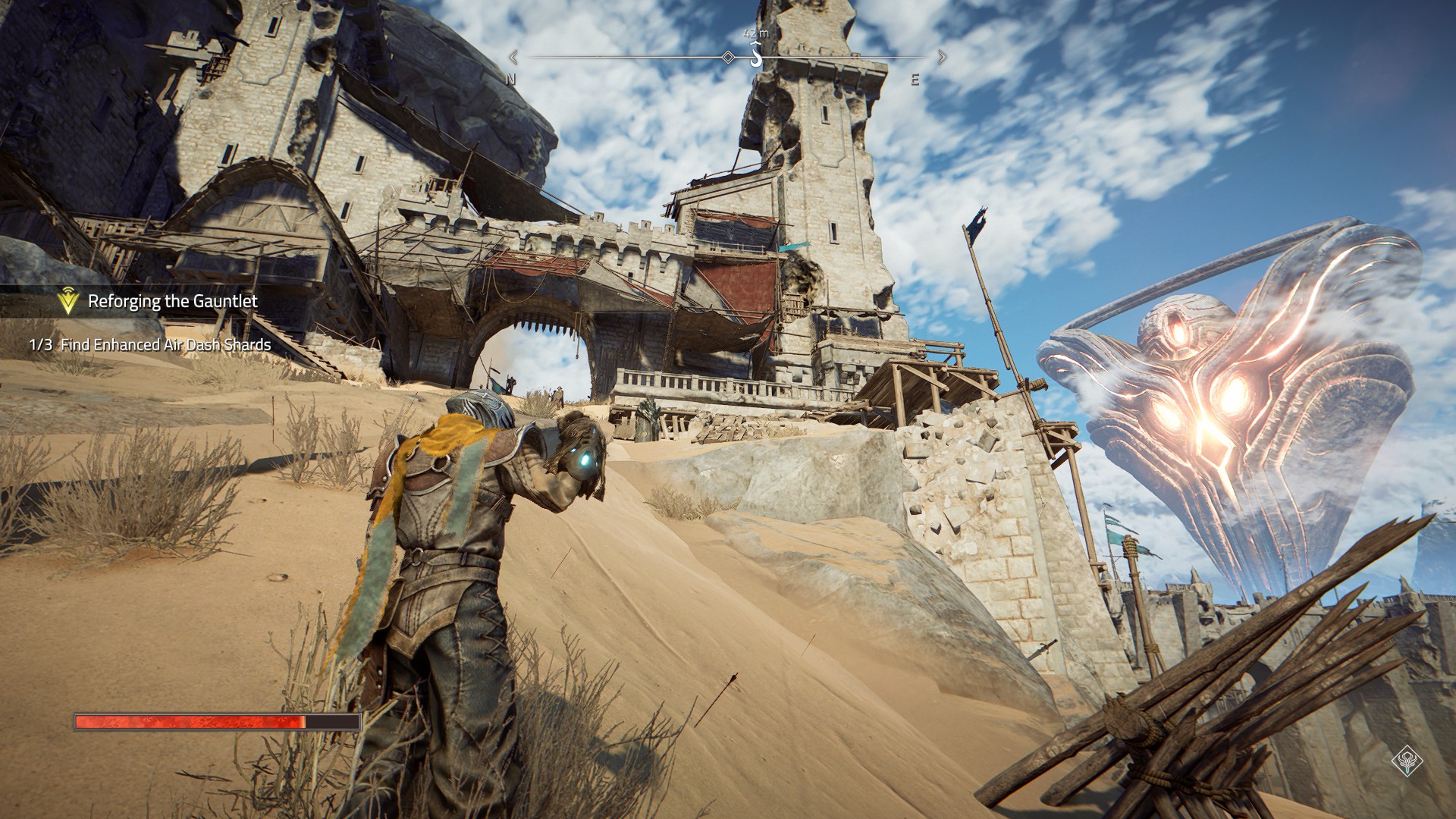
Nyaal and the Unnamed find themselves with not only a mission to save the Unnamed’s friend and mentor, but also to rebuild and find the scattered pieces of the gauntlet, revive the order of Bastengar Knights decimated by the last use of the gauntlet, unearth Nyaal’s real story, and evade capture by the unhinged Captain Morrath, intent on the gauntlet for himself. Add in a maniacal queen and an all-seeing alien Sauron entity called Thelos sitting in the sky and there is the recipe for a good fantasy adventure.
It does still stumble at times, but I found myself more interested in this adventure than I had guessed I might coming in. Nyaal and the Unnamed do a great job drawing you in and after only a few hours you’ll find many reasons to get invested in the story of the Knights. In such a ravaged world I found myself helping NPCs a little more than usual too. I mean, this guy is stranded in the desert, he needs my help, right?

Slide!
If someone says slide, I think of the little penguin power animal in Fight Club. In Atlas Fallen: Reign of Sand, sliding is the main method of traversal and in my opinion, it was the mechanic that was going to make or break the game. If the dune-sliding was cool and fun, then it was going to fire off dopamine all the time and make me happy. If the sliding was bad, I was going to be forever shunted and stopped and disappointed in hundreds of tiny moments throughout the game. I can safely say, in Reign of Sand at least, the sliding is smooth like butter. When you manage to slide from one objective to the next without break, curve round obstacles, and send yourself into constant satisfying leaps it can be really fluid.
Atlas is a sand dune-covered expanse, but don’t let that fool you into thinking its barren. If anything it’s more interesting than the grassland-covered open-worlds we have been fed for many years. There are ruins everywhere, rocks and outcroppings, and great gaping chasms that just fall forever. It feels a little like what the Shattered Plains from Brandon Sanderson’s books might look like if they were ever committed to video games. Diving over a chasm when the bridges are all knocked out is an early highlight.
For a world so vast and desert-covered, there is a remarkable amount of verticality in the ruins and areas you visit, demanding all manner of platforming and use of the various dashs and boosts you collect. I hadn’t felt so alive exploring a ruin since early Assassin’s Creed titles. I was actually surprised by the platforming and the fluidity of movement throughout.
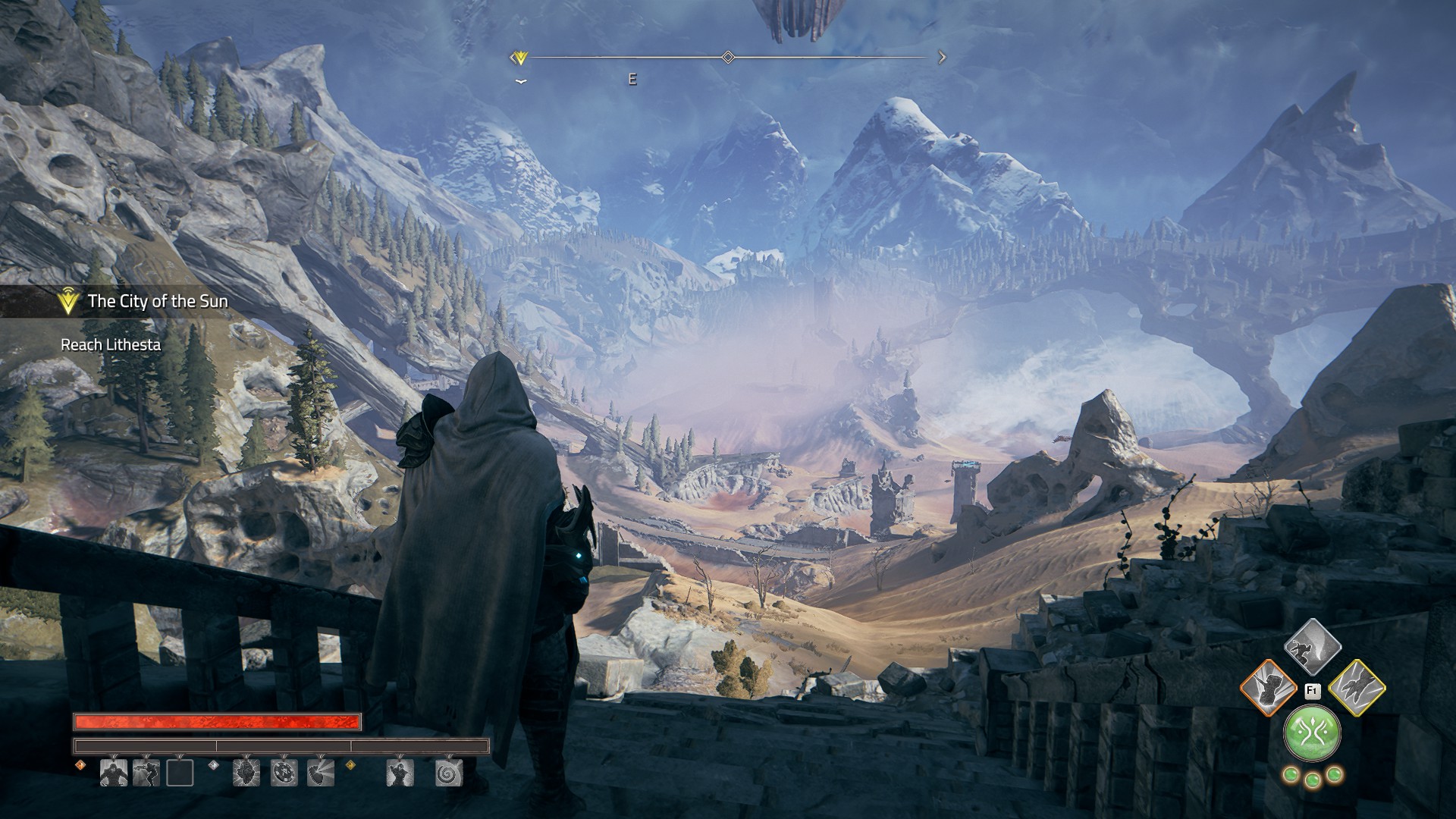
NPCs are scattered across the map, and often had quests and things for me to do. There were plenty of platforming style ones, exploring ruins for example, but also many involving searching for lost Unnamed, combat encounters with Wraiths and constantly driving towards upgrading your gauntlet to take on the next big requirement of the story. The gauntlet can raise structures out of the sands, and so much is made of that in the mechanics with raising chests, fast travel points and platforming towers available at every turn.
Every quest or interaction you complete rewards you with Essence and Tribute. Tribute is a kind of money system and Essence is the magic that had been drained from the sands. Many quests give out recipes for combat upgrades, or Idols (which were healing upgrades), or armour sets, or cores to expand your repertoire of skills. It is a constantly dopamine-hitting attainment system but in a single-player game, and had me stuck into the open-world system without complaint for far longer than I usually remain.

To Bring Down a God
So those upgrades and skills have to go somewhere, and if it’s not into traversal skills it’s generally into combat. Atlas is covered in monsters and encounters with Wraiths, a term used to cover all enemy types. Combat is something akin to a God of War-style action adventure, but has a teensy bit of the Souls flavour, with parrying being a focus. You of course have the gauntlet, but it can manifest into huge damage-dealing hammers, far-reaching whips, and much else besides. Your dodge and dash buttons keep you constantly in the action putting pressure on enemies.
Parry is a little unique in Atlas Fallen: Reign of Sand, in that it has a pretty forgiving timeframe to be used, almost like a block or hold function. When an enemy flashes red, hit parry and you retaliate with a kind of crystallisation, enough to freeze enemies in place and allow for a few quick hits. This is great on bosses too although they often need multiple successful parries in a row to freeze up completely. I think every enemy came with a weak point that if you could direct your attacks and lock on to, would shatter and end the fight faster.
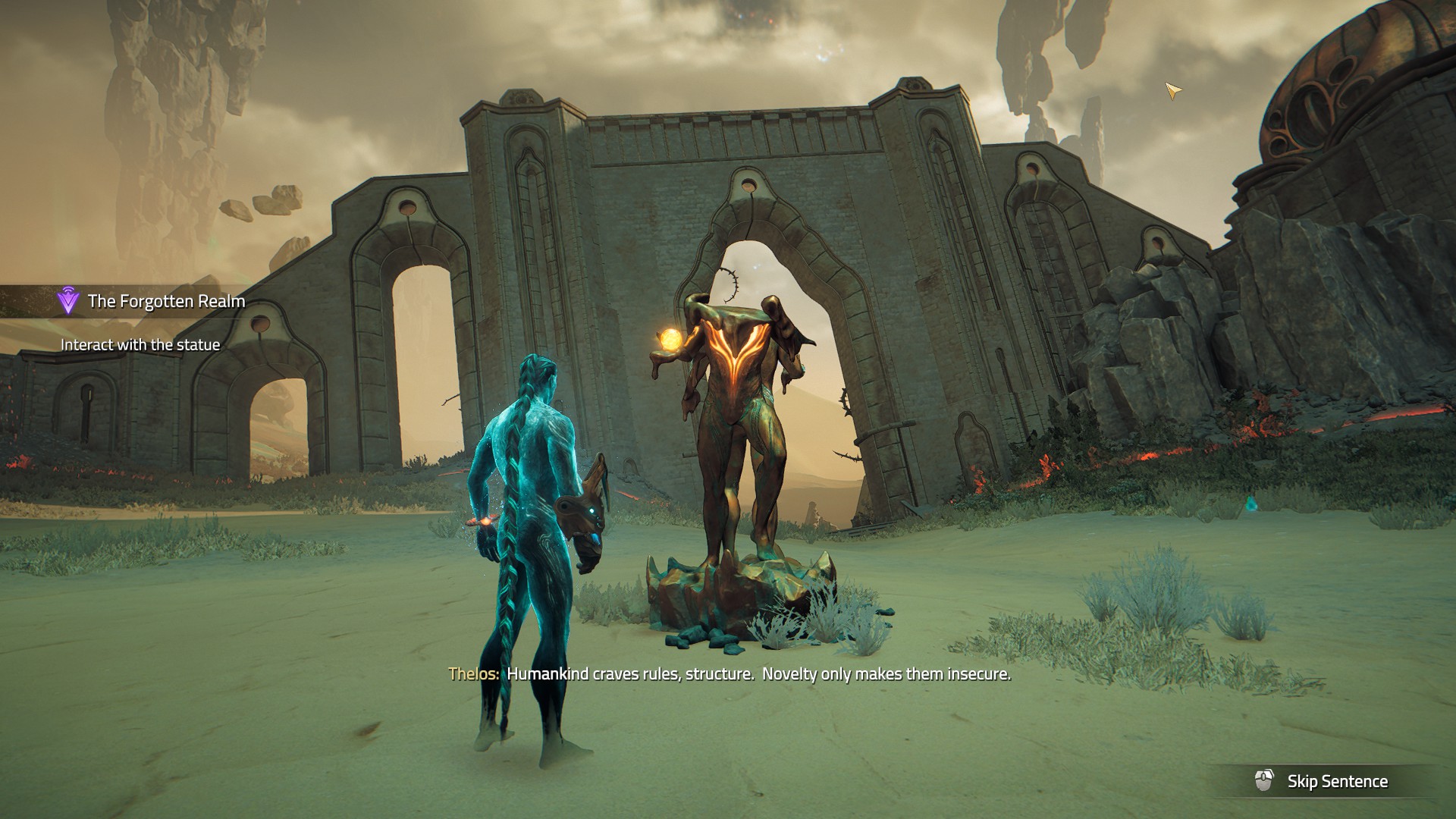
We should also talk verticality here. Flying enemies aren’t the bane of the game as they can often be, even though you don’t have a ranged weapon. Jumping and hitting them starts the fights, but you can stay in the air for entire battles if you intersperse your attacks with dashes that sort of reset the gravity and keep you going. It’s great fun and once mastered, makes you feel pretty powerful. My major gripe with this was the lock-on system that seemed to deliberately make it hard to switch between enemies, basically to the point I had to turn the camera so that particular annoying flying enemy was the only one on-screen before locking on and dealing with him, and then being able to go back and concentrate on the gigantic crab trying to fricasse me.
The last part of combat to mention is Momentum. This is a gauge that builds up at the bottom of the screen, giving you access to bigger and better skill and power attacks. It’s broken into three parts and parts get used up and then begin rebuilding when you use powers. Sounds great, right? Well its also something of a double edged sword – the higher your momentum goes the harder you hit and the more power you have, but also the more dangerous and strong the enemies get. At high momentum you run the risk of a single hit hurting a lot more than it would have done at low momentum. It’s a really interesting risk/reward mechanic that allows you to tease and dodge and build up power, but also encourages you to use it up and not hoard it.

A Single Grain of Sand
So I played Atlas Fallen: Reign of Sand on a capable PC with a better-than-recommended processor and graphics card. I turned down a lot of the high textures and any FPS over 60 because I didn’t need it taxing things. Atlas Fallen ran smoothly at a good consistent framerate and the graphics were as intended. I don’t think the world looks completely realistic, and some creative license has been used, but it is generally pretty. NPCs and such are okay, but they were towards the lower end of the quality scale. The only graphical issues I ever had was a bit of screen tearing here and there, but I’m sure it was a limitation of my hardware. For example, testing it on PS5 showed none of this issue.
I think graphically, beyond the technical argument, Atlas Fallen: Reign of Sand has a look that comes from good art direction. There’s a uniformity to the world and its designs, to the ruins and the clothes and the rolling dunes, that makes it feel lived in, and manages to give it that tantalising uniqueness that sets it apart.
I’ve mentioned Ben Starr’s great turn as the male Unnamed voice, but many of the voice actors give good performances. This isn’t your anime crowd of voices, this is more western, and I never even felt an NPC stood out as having a jarring performance. Musically there’s a good soundtrack with desert-style instruments and melodies for exploration, and drums for combat and it again felt in keeping with an actual deliberate design intention.
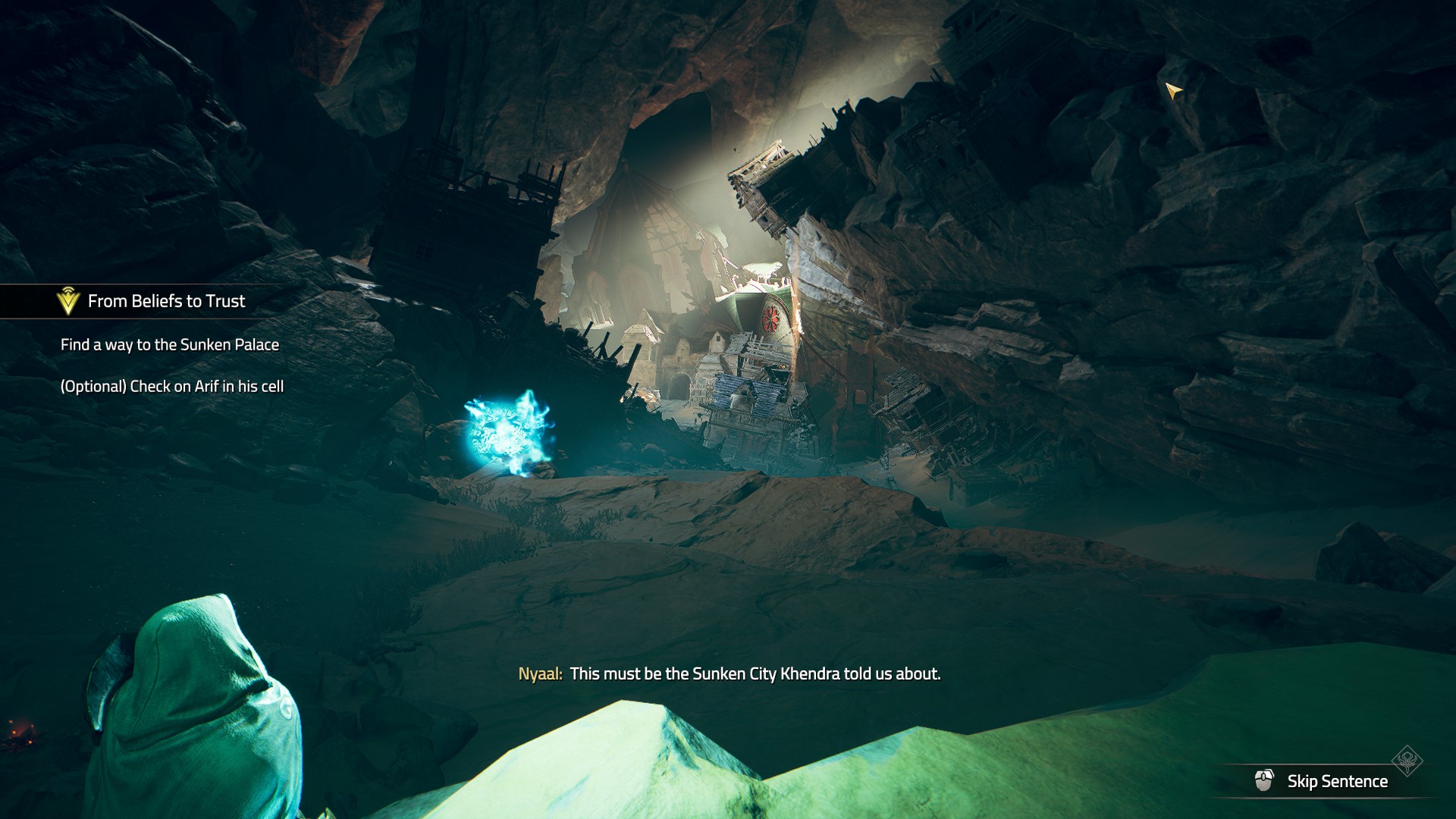
Sandstorm
Atlas Fallen: Reign of Sand isn’t the biggest open-world time sink out there. The open world is presented in a few smaller chunks, and the narrative drives things forward again every few hours. It isn’t one where you’ll need dozens of hours to see and find everything. Instead, with cold focus and some skill you could complete the narrative in about less than 15 hours. It’s closer to 25 hours with a bunch of fun side quests, treasure hunts, and probably more traversal than fast travel because of the fun sliding.
The Reign of Sand overhaul has really done wonders for Atlas Fallen, introducing a tight narrative that hooks you in quickly and a good central character to latch onto. For newcomers this is without doubt the best the game has been and the only way to choose to experience it. For those who already liked it, the update is free and comes with new difficulty, new game+, new areas and new abilities to add to the seemingly endless number of cores you can equip.
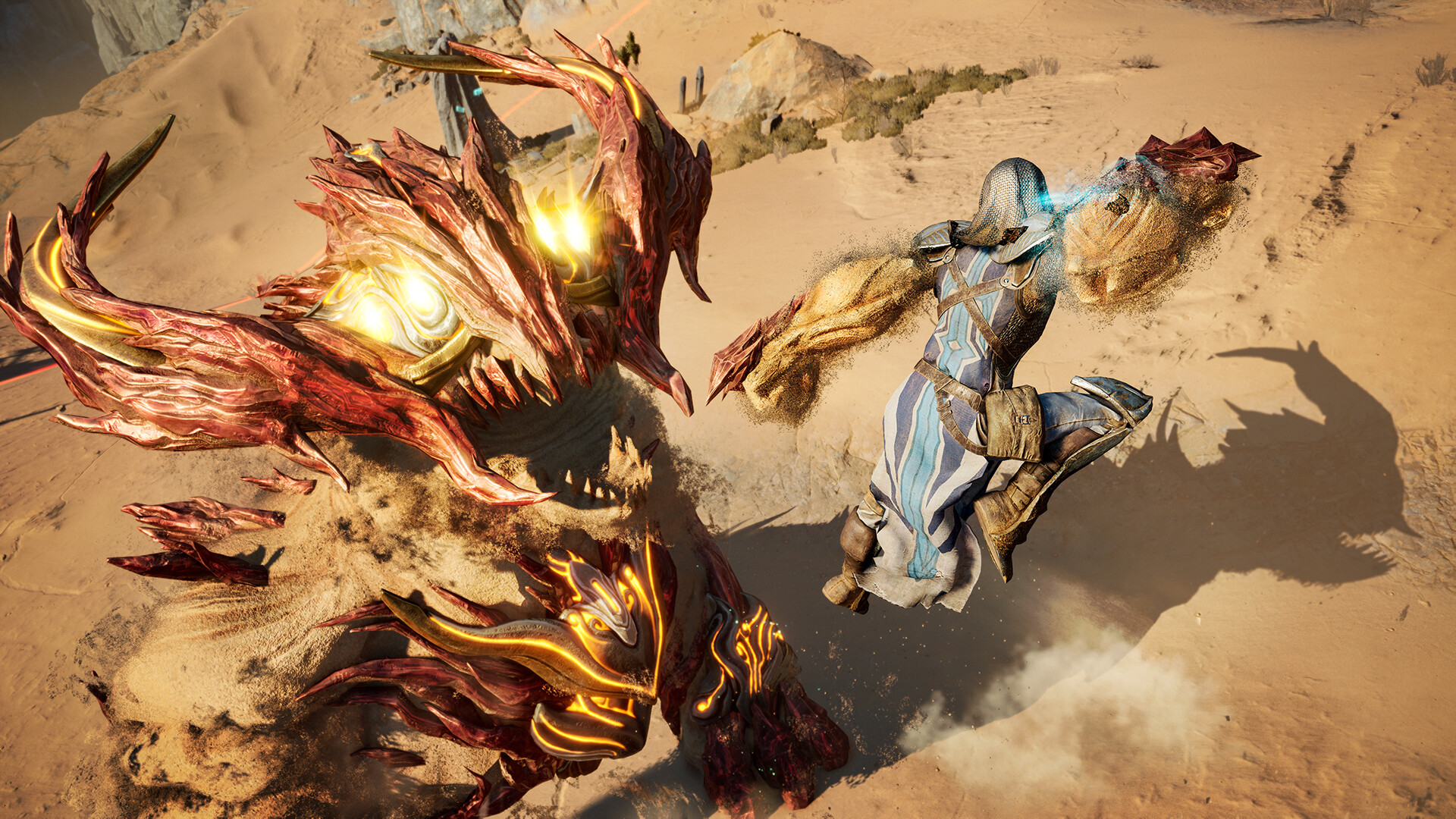
I nearly took the plunge on Atlas Fallen last year but didn’t for any number of reasons. I know what kind of game will get me invested and it’s almost always story first and gameplay second. Hearing the story was weak and not well implemented was enough to make it a wait-and-see. Had I played it before I think I would have bounced off in a similar way to other players. However, with Reign of Sand, my first foray into the dunes has been with the narrative front and centre, good voice acting and exposition giving my quest mystery and intent from the get-go.
Atlas Fallen may have stumbled at launch but it’s picked itself up, dusted itself off, and with Reign of Sand, climbed on the shoulders of its predecessor to deliver its Definitive Edition. I’ll certainly be counting it amongst those games, like Cyberpunk 2077 or Final Fantasy 14, that reinvented themselves and were able to finally realise their true potential.
A major update to Atlas Fallen, Reign of Sand brings a tight narrative focus and voice acting that reworks what existed into a really enjoyable AA adventure. Sliding through the dunes on your quest to find the Knights and overthrow a god is made all the more fun with a great powertrip of a combat system. Atlas Fallen: Reign of Sand is the Definitive Edition and I’m so glad the developers gave it the overhaul it deserved.

Atlas Fallen: Reign of Sand is available now on PC via Steam (review platform), PlayStation 5, and Xbox Series S|X.
Developer: Deck 13
Publisher: Focus Entertainment
Disclaimer: In order to complete this review, we were provided with a promotional copy of the game. For our full review policy, please go here.
If you enjoyed this article or any more of our content, please consider our Patreon.
Make sure to follow Finger Guns on our social channels –Twitter, Facebook, Twitch, Spotify or Apple Podcasts – to keep up to date on our news, reviews and features.
